Protecting Your Sodium Hypochlorite Chemical Tank From UV Exposure
If your sodium hypochlorite chemical tank (or any tank, for that matter) is located outdoors, it’s exposed to the elements, such as sun, wind, and rain. Special considerations are recommended to protect the life of the chemical and the storage tank, especially from damaging ultraviolet rays from the sun.

Let’s explore the challenges and storage solutions for sodium hypochlorite tanks located outside.
Sodium hypochlorite breaks down from exposure to elevated temperatures and ultraviolet (UV) light. The temperature threshold for breakdown of bleach is typically above 90°F. The hotter the temperature, and the more prolonged the exposure to the heat, the faster the chemical will break down.
Extended UV exposure weathers your polyethylene storage tank prematurely. Without proper treatment or cover, the higher energy spectrum of the UV light causes a compound breakdown of the polyethylene elements, making the polyethylene tank material brittle.
When the tank becomes brittle, it can cause micro cracks, which lead to leaks and potential failure of the chemical storage tank.
Solutions to Reduce the Risk of Chemical and Tank Exposure to UV
Let’s explore three different solutions to protect outdoor polyethylene storage tanks from UV damage.
Carbon Black Resin

Carbon Black is a nearly pure elemental carbon. When used as a resin in the molding of the polyethylene tank, it acts as an absorber of UV light. Adding Carbon Black is a simple, inexpensive solution to creating an internal stabilizer to your polyethylene chemical tank. The resin absorbs UV energy, transforms it into heat, and dissipates it throughout the tank.
While Carbon Black polyethylene tanks tend to have slightly higher temperatures than lighter colored or white polyethylene tanks, the UV protection outweighs the effects of the small increase in temperature. Carbon Black is the preferred pigment in higher-end applications, especially when storing harsh chemicals such as sodium hypochlorite.
Paint Your Own Tank
Painting the tank can reflect the UV rays and help reduce heating. If you paint your polyethylene tank, it's best to do it on-site. This allows the surface to oxidize a bit and also protect it from potential scratches during transportation and installation.
We recommend lightly bead-blasting the tank surface before painting, to ensure the paint adheres. You can also set the tank in the sun for a few months and allow the outer surface to oxidize naturally, then apply the paint.
If you choose to paint your chemical storage tank, be sure to follow proper procedures and to use a paint that won’t crack or flake with tank expansion. An acrylic or elastomeric paint, which expands and contracts with the tank, is best.
Painting a polyethylene tank is similar to painting the outside of a home or business. Paint can be applied in the traditional ways using airless sprayers, power sprayers, rollers, or even brushes but surface preparation is a key.
Download our guide for painting polyethylene storage tanks to get the most out of your painted tank.
Insulation and Paint
If you’re located in a hot area like Arizona or Florida, we often have customers who insulate the tank to protect it from ambient heat. Insulation does an excellent job of blocking UV rays while maintaining a cooler temperature of the chemical being stored. We apply two inches of insulation and a coating of industrial grade paint at the factory before the tank ships.
This is often an ideal solution for chemicals that degrade under higher temperatures, such as sodium hypochlorite.
For questions regarding storing sodium hypochlorite outdoors, or for a custom storage tank system solution, contact a Poly Processing storage tank specialist.
- October 25, 2021
- Topics: Chemical Storage
About Poly Processing
Posts By Topic
Tech Talk Podcast Episodes
Subscribe By Email
Recent Posts
- Installation Tips for Chemical Storage Tanks: Site Preparation and Offloading
- Understanding pH and Chemical Concentration When Choosing a Chemical Tank
- Maximizing Fill Efficiency: Selecting the Optimal Fill Line System
- Chemical Storage Tanks: A Quick Guide for End Users
- Popular Customization Options for Chemical Storage Tanks
Tank Configurator

Find the recommended tank and system components for your chemical storage challenge.
Configure a Tank Package



